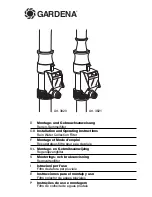
input attenuator. Lower signal levels will give a much wider range of signal
coloration/alteration, while overdriving the input of the filter will give a very
harsh distortion and destroy most of the filtering subtleties.
If you find that the filter seems too "touchy", and overdrives too easily
for you, try attenuating the signal before the module. Another symptom of
too-high input levels is if the controls seem to not do much at all - this is the
most common question I receive.
Controls
High:
Okay, a confession: The controls are technically labelled
incorrectly.
High actually controls the cutoff frequency (f
c
) of the lowpass
portion (how much of the high end is let through), while
Low controls the f
c
of the highpass section (how much of the low end is let through).
Having said that, clockwise rotation of the High
control increases the high
end of the signal. This also increases the resonance of the filter. Applying an
increasing CV to the High CV input will act the same as clockwise rotation.
Low: This one is rather weird. Clockwise rotation of the Low control
will increase the amount of the low end passed through the filter (i.e., it
lowers the highpass f
c
), and dramatically boosts the resonance. Applying an
increasing voltage to the Low CV input also acts as clockwise rotation, which
is the weird part: Increasing the Low CV lowers the highpass f
c
, allowing
more low end through.
Gain:
Controls the gain of the filter. Clockwise to increase, yadda
yadda yadda...
2
The part to keep in mind is that increasing the gain increases
the resonance, and the PB was designed to go absolutely nertz from this.
The filter will easily oscillate and scream at you. This usually occurs when
processing an audio signal and can be heard as an additional voice.
The gain also directly controls the amount of internally-generated
noise fed through while the input is at or near minimum.
See page 6 for further details on self-oscillation and noise.
The VC Gain has inverted behavior - 0V is maximum gain, +12V is
minimum gain. Several inversion circuits were tried to change the behavior
to "standard" action, but the most reliable designs added too many
components and assembly time to keep the price below USD$100.00, and
keeping the price low is a
major
design goal with the Plague Bearer.
Input: This is the input attenuation control as mentioned above.
2. Equivalent to "blah, blah, blah..."
4/7


























